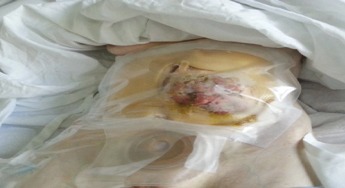Management of Pseudomyxoma Peritonei
This case study looks at the management of Pseudomyxoma Peritonei using eakin Wound Pouches™
By Deb Day, Stomal Therapy CNC Central Coast Local Health District, Australia
Patient background
A 47-year-old lady who had been diagnosed with Pseudomyxoma Peritionei 13 years earlier. She had multiple surgeries and a left-sided, high output ileostomy. The lady was very independent and lived at home on total parenteral nutrition (TPN) and intravenous fluids (IVF) via a Hickman’s Line.


The lady presented to STN clinic in July 2014 and was referred back to her surgeon who diagnosed disease recurrence of Pseudomyxoma Peritonei. It was later decided that the lady would not have any further surgery.
Care Management Plan
The lady was managed under Palliative Care and continued to receive TPN, IVF and blood transfusions alongside the use of a syringe driver for pain relief.


Pouching the Pseudomyxoma Peritonei with eakin Wound Pouches™ was an appropriate choice as they provided comfort, odour control and containment of fluid from the wound. They also reduced the workload for the nurses providing care.
Outcome
• Provides containment of fluid.
• Provides comfort and odour control for the patient.
• Reduced nurse workload.
• No additional componentry or reliance on resources such as electricity.


 US
US 
